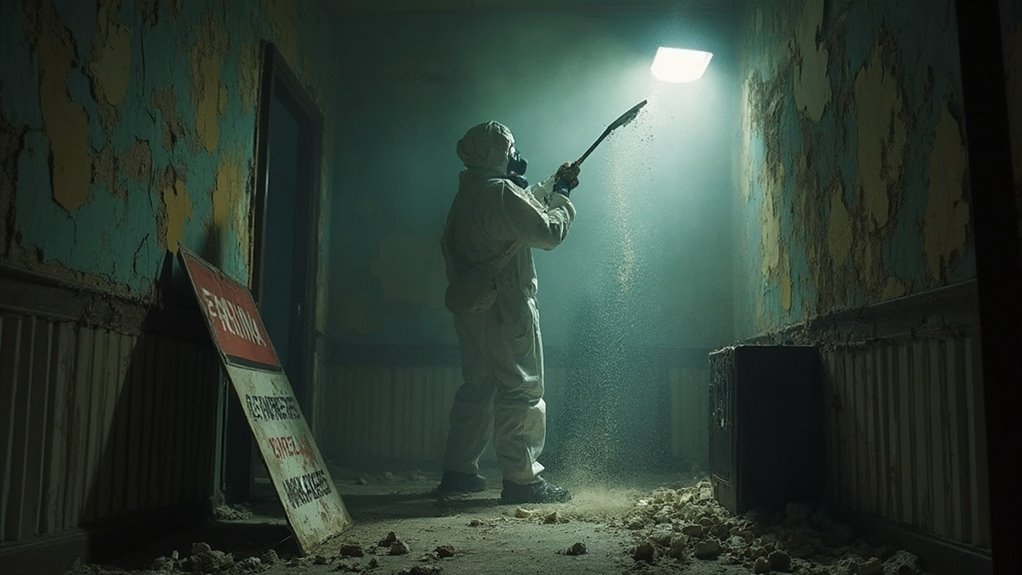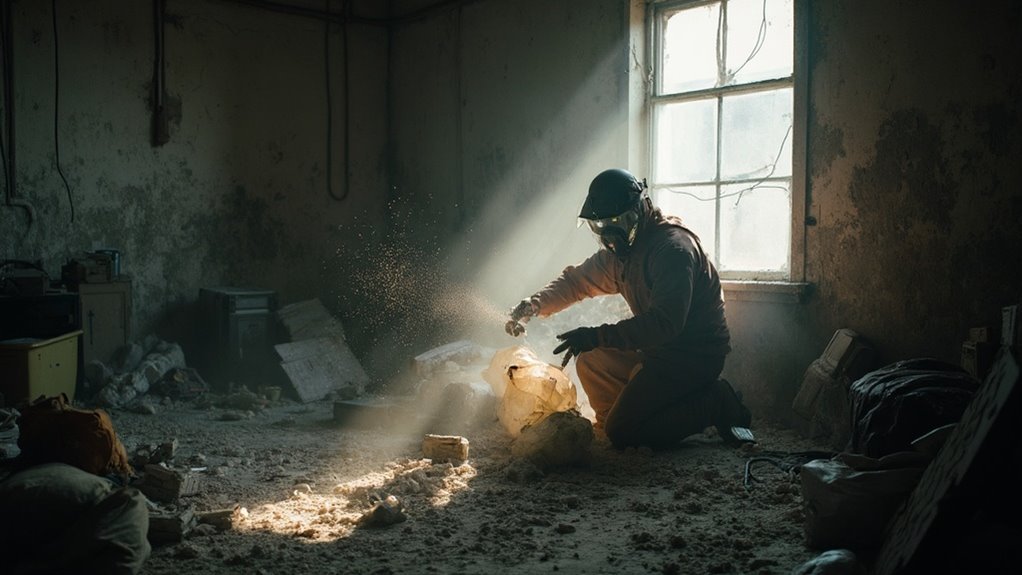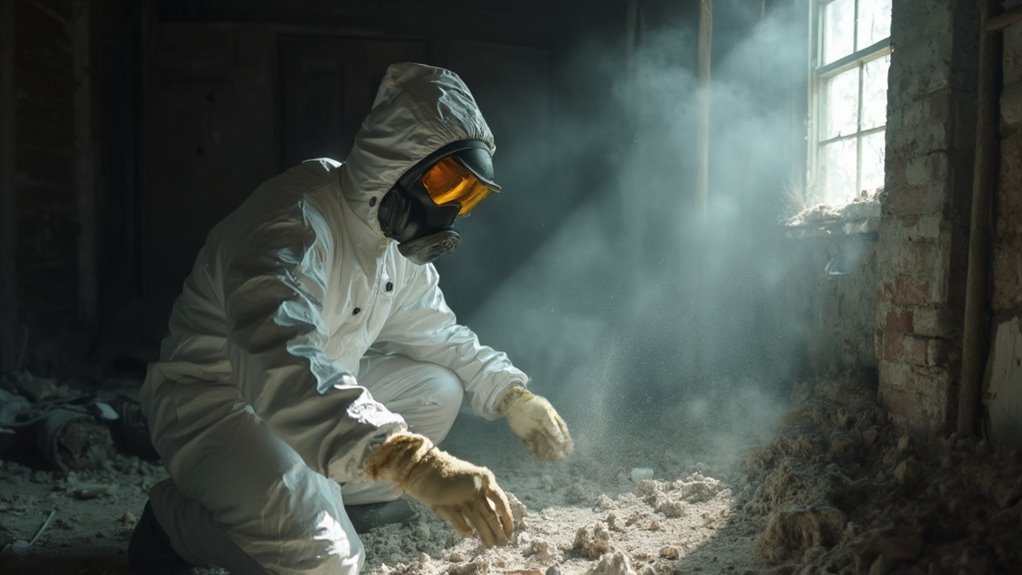Asbestos removal isn't just a simple task; it's a meticulous process that requires stringent procedures to guarantee safety. Before starting, confirm the presence of asbestos through thorough testing. You must use protective gear and follow strict containment protocols to prevent fiber dispersal. Licensed professionals should handle removal, utilizing negative pressure machines and wet methods to minimize risk. Improper removal can lead to severe health consequences, including lung cancer and asbestosis. Be aware of both federal and state regulations governing disposal. Understanding these intricacies is vital for your safety and health, so keep exploring to uncover more important details.
Understanding Asbestos Removal

When it comes to understanding asbestos removal, it's vital to recognize the importance of proper procedures to guarantee safety. First, you must confirm the presence of asbestos through material testing. If asbestos is detected, sealing off the area with plastic sheeting and negative air pressure machines is critical to prevent fiber dispersal. Removal techniques often involve hand tools and wet methods, particularly for challenging materials like popcorn ceilings. Additionally, ensuring that proper ventilation is maintained during the removal process is essential to minimize inhalation risks.
Worker safety can't be overstated; certified professionals must wear protective clothing and respirators to minimize exposure risks. You'll find that only trained individuals with removal certifications should handle the process, adhering strictly to asbestos regulations that govern safety and disposal. Asbestos waste requires specialized disposal in licensed landfills, following stringent regulations to mitigate health risks. Professional teams are essential for effective abatement, as they ensure that the removal process is conducted thoroughly and safely.
In some cases, encapsulation might be a cost-effective alternative if the asbestos materials are intact. Nevertheless, removal becomes necessary when the materials are damaged or friable, which poses a greater risk of fiber release. Understanding these steps guarantees not only regulatory compliance but also the safety of everyone involved in the asbestos removal process.
Preparation for Safe Removal
Preparing for safe asbestos removal involves several critical steps to guarantee compliance and protect health. First, conduct a thorough asbestos inspection with a licensed professional who can identify all materials containing asbestos. This initial assessment is crucial for effective removal planning, which should detail the scope of work, containment measures, and safety protocols for workers.
Here's what you should focus on:
- Get a written contract specifying the work plan and compliance with regulations.
- Seal off work areas using plastic sheeting to prevent fiber spread.
- Arrange for temporary relocation if the removal work is extensive.
Before removal begins, verify you understand federal, state, and local laws regarding asbestos disposal, and meet any notification requirements. Clear the area of personal belongings and turn off HVAC systems to avoid circulating fibers. It's also important to minimize activities in affected areas and prepare for worker safety with appropriate protective gear. Following these steps will help create a safe environment for both workers and residents, greatly reducing the risk associated with asbestos exposure during the removal process. Additionally, ensure that the asbestos inspection process is conducted by certified professionals to guarantee accurate identification of hazardous materials.
Common Removal Techniques

When dealing with asbestos, you'll often choose between complete material removal and encapsulation for preservation. Each technique comes with its own set of dust control strategies to guarantee safety during the process. Understanding these common removal techniques is crucial for effective asbestos management.
Complete Material Removal
How can you guarantee the safe and effective removal of asbestos materials? Complete material removal is vital, and employing the right techniques is fundamental. The wet removal method is one of the most effective strategies. By wetting asbestos materials with a solution of water and a wetting agent, you greatly reduce airborne fibers during the removal process. Continuous moistening keeps debris manageable, while hand tools like chisels and scrapers minimize dust creation.
Here are some key steps for successful asbestos removal:
- Double Bagging: Seal asbestos debris in two leak-tight bags, clearly marked as hazardous materials, to prevent fiber release during disposal.
- Careful Handling: Avoid breaking materials into smaller pieces, which can release more fibers, ensuring a safer removal process.
- Final Cleanup: Use wet mops, rags, or HEPA vacuum cleaners to eliminate any remaining fibers, ensuring the area is clean and safe.
Encapsulation for Preservation
Encapsulation techniques are frequently employed as a viable alternative to complete asbestos removal, especially in situations where the materials are in good condition and pose minimal risk. These preservation techniques provide several encapsulation benefits, including cost-effectiveness and minimal disruption.
Spray encapsulation is often used for large areas, applying a sealant that hardens to form a durable barrier. For smaller or intricate spaces, a brush or roller application guarantees thorough coverage. Mechanical encapsulation uses boards or sheets, creating a physical barrier, while high build elastomeric coatings improve durability, especially for fibrous materials.
One significant advantage of encapsulation is its ability to prevent asbestos fiber release into the air, thereby reducing health risks. This method allows asbestos-containing materials (ACMs) to remain intact, preserving the building's original architecture while minimizing the need for temporary closures. Moreover, encapsulation can offer a long-term solution, as it stabilizes ACMs and reduces exposure risks over time, provided regular monitoring and maintenance are conducted.
Dust Control Strategies
Effective dust control strategies are fundamental during asbestos removal to minimize health risks and assure safety for workers and building occupants. Implementing proper techniques not only guarantees fiber containment but likewise improves dust suppression throughout the removal process.
To achieve effective dust control, consider these strategies:
- Use wet methods: Wetting asbestos materials before removal prevents fiber release into the air.
- Negative air pressure machines: These devices help contain fibers within the contaminated area, preventing their spread.
- HEPA filtration: Employ HEPA vacuums for cleaning residual fibers and making air quality remains safe.
Clear demarcation of contaminated areas and sealing off non-affected sections with tarps are crucial for preventing cross-contamination. Always shut off HVAC systems to avoid circulating contaminated air. Regular air-quality testing will assure that asbestos levels remain within safe limits.
Finally, after removal, confirm thorough cleaning of surfaces using damp methods to capture any remaining dust. Proper disposal protocols, including dust-tight containers for asbestos waste, are fundamental to maintaining a safe environment. By following these strategies, you'll considerably reduce the risks associated with asbestos removal.
Health Risks of Asbestos
Asbestos exposure can lead to serious long-term health effects, including diseases like asbestosis and lung cancer, which often manifest years after initial contact. You might not experience immediate symptoms, but the danger lies in the cumulative damage caused by inhaling asbestos fibers. Understanding these risks is essential for making knowledgeable choices about asbestos removal and your safety.
Long-Term Health Effects
When you consider the long-term health effects of asbestos exposure, it becomes evident that the risks are severe and often life-threatening. Asbestos awareness is essential, as the diseases caused by exposure can take decades to manifest.
Key long-term health effects include:
- Lung Cancer: The risk greatly increases with smoking and usually arises 15-50 years post-exposure.
- Mesothelioma: This aggressive cancer can develop 20-40 years after exposure, affecting the linings of the lungs and abdomen.
- Non-Malignant Lung Diseases: Conditions like asbestosis can reduce respiratory function over 20-30 years, leading to serious health complications.
Health surveillance is important for those at risk, as early detection can improve outcomes. Understand that the global impact of asbestos exposure is staggering, claiming over 200,000 lives annually. The prevention of these diseases hinges on stringent regulations and raising awareness about the dangers of asbestos. By cultivating an informed community, we can work towards eliminating exposure and safeguarding future generations.
Immediate Symptoms of Exposure
Exposure to asbestos can lead to immediate symptoms that often go unnoticed at first, but recognizing them is crucial for early intervention. Many of these symptoms may mimic typical respiratory issues, which can result in delayed diagnosis and treatment. Being aware of these signs can markedly impact your health outcomes.
| Symptom | Description | Disease Association |
|---|---|---|
| Chest Pain | Commonly mistaken for respiratory problems | Asbestosis, Lung Cancer |
| Persistent Cough | Can be dry or produce mucus | Asbestosis, Mesothelioma |
| Shortness of Breath | Difficulty breathing that gradually worsens | All asbestos-related diseases |
| Crackling Sound in Lungs | Dry sounds heard during inhalation | Asbestosis |
Immediate symptoms like chest pain, persistent cough, and shortness of breath should prompt you to seek medical advice. Inflammation and scarring from asbestos fibers can lead to serious respiratory complications over time. Awareness of these symptoms and their implications is crucial for effective symptom recognition and timely intervention. Remember, while symptoms may not seem severe initially, they can indicate underlying issues requiring prompt attention.
Environmental Impact of Asbestos

Revealing the environmental impact of asbestos reveals a complex interplay between natural occurrences and human activities. Asbestos naturally forms in certain rocks and can be released into the environment through disturbances. As you learn about the consequences, consider how asbestos mining and construction activities greatly contribute to environmental contamination.
- Asbestos fibers can remain suspended in air for long periods, posing long-term inhalation risks.
- Water sources may become contaminated with asbestos, leading to potential ingestion.
- Illegal disposal practices worsen the spread of asbestos, further endangering communities.
Each year, hundreds of millions are exposed to asbestos globally, with a staggering number of deaths attributed to related diseases. Those living near former mines or natural deposits face heightened risks. Natural disasters can likewise spread fibers, compounding the issue. The persistence of asbestos in the environment means that even areas far from mining sites can be affected. Understanding these dynamics is essential for recognizing the urgent need for effective asbestos management and remediation strategies to protect public health and the environment.
Regulatory Concerns
The complex environmental impact of asbestos underscores the urgent need for robust regulatory frameworks to manage its removal and prevent further contamination. As you navigate the intricacies of asbestos removal, it's essential to understand the regulatory compliance requirements imposed by federal, state, and local authorities. The National Emission Standards for Hazardous Air Pollutants (NESHAP) enforce specific work practices and disposal requirements during demolition projects, necessitating proper notifications to government agencies before work begins.
However, enforcement challenges arise because of inconsistencies between federal, state, and local regulations. For instance, states like Indiana have their own unique rules that may conflict with federal guidelines, leading to confusion among contractors. Furthermore, contractors must be licensed and inspectors certified to guarantee compliance.
Despite stringent regulations, the lack of an all-encompassing ban on asbestos in the U.S. complicates the environment further. Legacy asbestos in buildings continues to pose significant health risks, and the influence of the chemical industry on regulations raises ongoing concerns. Addressing these regulatory challenges is essential to safeguarding public health during asbestos removal processes.
Essential Safety Precautions

When undertaking asbestos removal, implementing crucial safety precautions is critical to protect both workers and occupants. Proper safety equipment and protective clothing are necessary to minimize exposure to hazardous fibers. Start by confirming everyone involved wears appropriate respiratory gear, such as half-face filter respirators with class P1 or P2 filters. Remember, a tight seal is fundamental, so clean-shaven faces are required.
Before removal, take these precautions:
- Evacuate all personnel from the vicinity.
- Seal off non-affected areas with tarps to contain dust.
- Wet down asbestos materials to prevent fiber release during removal.
Use disposable coveralls, gloves, and hats to avoid contamination. Choose synthetic fabrics that block asbestos fibers, and always use thick shoes to protect against tears. Once the removal is complete, clean the area thoroughly with HEPA vacuum cleaners and wet mops.
These crucial precautions not only safeguard those performing the removal but also guarantee the safety of others in the vicinity. Always prioritize safety equipment and protective clothing throughout the process to maintain a secure environment.
Post-Removal Best Practices
Post-removal best practices are essential for guaranteeing a safe and thorough cleanup after asbestos abatement. After the removal process, conduct post removal inspections to verify the effectiveness of your efforts. Use specialist equipment, like borescopes and fiber-optic cameras, to check confined spaces for any missed asbestos residue. Collect air samples and analyze them using microscopy techniques to confirm they meet regulatory clearance criteria.
Proper waste disposal is just as significant. Package asbestos waste in two layers of 0.2 mm thick polythene sheeting, sealing it tightly with adhesive tape. For smaller debris, double bag it and label each package clearly as "ASBESTOS WASTE." Fill bags only halfway to minimize the risk of splitting and avoid releasing dust. Make certain to transport this waste securely to a licensed disposal site.
Finally, decontaminate all equipment used during the removal process. Employ wet wiping methods or HEPA vacuums to clear contaminants effectively. Conduct ongoing air monitoring to affirm the environment is safe for reoccupation. Following these post-removal best practices guarantees the safety of everyone involved and maintains compliance with regulations.
Frequently Asked Questions
Can Homeowners Legally Remove Asbestos Themselves?
Yes, you can legally remove asbestos yourself in single-family homes, but DIY risks are significant. Be aware of local legal regulations and the dangers of exposure; hiring a certified contractor is often safer and more compliant.
How Long Does the Asbestos Removal Process Typically Take?
Asbestos removal's like untangling a web; the project duration varies. Small jobs may take days, while larger ones could extend weeks. Factors like type, area complexity, and safety measures dictate the removal timeline considerably.
What Should I Do if I Suspect Asbestos in My Home?
If you suspect asbestos in your home, observe for asbestos symptoms and consider using testing methods. DIY kits are available, but professional testing guarantees accurate results and safe handling of potentially hazardous materials.
Are There Any Safe Levels of Asbestos Exposure?
Studies show that even minimal asbestos exposure can increase health risks, including lung cancer and mesothelioma. There's no safe level of asbestos exposure; any contact can be harmful, emphasizing the need for caution and professional assessment.
How Can I Verify a Contractor's Asbestos Removal Qualifications?
To verify a contractor's asbestos removal qualifications, check their credentials through training certificates, licenses, and insurance. Ascertain they've completed the necessary verification process, including recent physical exams and documentation of past projects.
